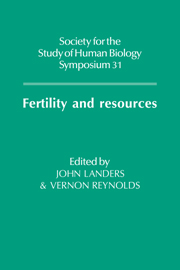Book contents
- Frontmatter
- Contents
- List of contributors
- 1 Introduction
- 2 Environmental and social determinants of fecundity in primates
- 3 Biological aspects of fertility among Third World populations
- 4 A preliminary report on fertility and socio-economic changes in two Papua New Guinea communities
- 5 The cultural context of fertility transition in immigrant Mennonites
- 6 Inter-relationships between consanguinity, religion and fertility in Karnataka, South India
- 7 Resources and the fertility transition in the countryside of England and Wales
- 8 Fertility decline and birth spacing among London Quakers
- 9 Population growth, innovation and resource exploitation
- 10 Fertility decline in developing countries: the roles of economic modernization, culture and Government interventions
- 11 Understanding recent fertility trends in the Third World
- 12 Monogamy, landed property and demographic regimes in pre-industrial Europe: regional contrasts and temporal stabilities
- Index
4 - A preliminary report on fertility and socio-economic changes in two Papua New Guinea communities
Published online by Cambridge University Press: 13 March 2010
- Frontmatter
- Contents
- List of contributors
- 1 Introduction
- 2 Environmental and social determinants of fecundity in primates
- 3 Biological aspects of fertility among Third World populations
- 4 A preliminary report on fertility and socio-economic changes in two Papua New Guinea communities
- 5 The cultural context of fertility transition in immigrant Mennonites
- 6 Inter-relationships between consanguinity, religion and fertility in Karnataka, South India
- 7 Resources and the fertility transition in the countryside of England and Wales
- 8 Fertility decline and birth spacing among London Quakers
- 9 Population growth, innovation and resource exploitation
- 10 Fertility decline in developing countries: the roles of economic modernization, culture and Government interventions
- 11 Understanding recent fertility trends in the Third World
- 12 Monogamy, landed property and demographic regimes in pre-industrial Europe: regional contrasts and temporal stabilities
- Index
Summary
The Wopkaimin people of the Star mountain census division were first contacted by the Australian government authorities in 1963 (Jackson, 1982). They number about 800 people (National Statistical Office, 1983) who live in seven villages scattered, over an area of about 1700 square kilometres, in the north-west corner of the Western Province of Papua New Guinea (PNG) (Figure 4.1).
Kennecott geologists, discovered copper in the area in late 1968 and by 1971a mining camp with the first school and aid post for the whole area was built at Tabubil. The first airstrip was completed in 1972. In 1981 after the Papua New Guinea Government approved the development of a copper and gold mine, the quiet Tabubil camp with 12 buildings rapidly became a township accommodating more than 3000 workers. Mountain sites were blasted, mining facilities constructed and roads bulldozed through with the most modern technology, engineering and machinery. The first and only government aid post was built in 1982. A road connection to the Fly River port of Kiunga, 150 km to the south, was completed in 1983.
The new development pushed the Wopkaimin from the Stone Age into the modern world. Their changed environment and lifestyle had an irreversible effect on their physical, mental and spiritual wellbeing. Villages were moved to be nearer the new developments (Figure 4.1). The people left their thatched houses and built themselves shacks in their new villages out of timber, iron and plastic left over by the mining company.
- Type
- Chapter
- Information
- Fertility and Resources , pp. 35 - 46Publisher: Cambridge University PressPrint publication year: 1990



